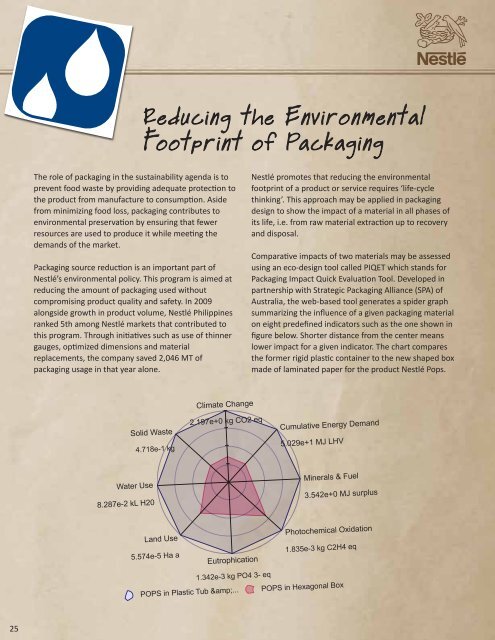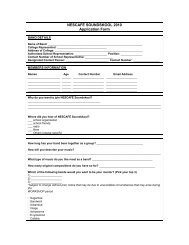Creating Shared Value Report - Nestlé Philippines, Inc.
Creating Shared Value Report - Nestlé Philippines, Inc.
Creating Shared Value Report - Nestlé Philippines, Inc.
You also want an ePaper? Increase the reach of your titles
YUMPU automatically turns print PDFs into web optimized ePapers that Google loves.
25<br />
The role of packaging in the sustainability agenda is to<br />
prevent food waste by providing adequate protection to<br />
the product from manufacture to consumption. Aside<br />
from minimizing food loss, packaging contributes to<br />
environmental preservation by ensuring that fewer<br />
resources are used to produce it while meeting the<br />
demands of the market.<br />
Packaging source reduction is an important part of<br />
<strong>Nestlé</strong>’s environmental policy. This program is aimed at<br />
reducing the amount of packaging used without<br />
compromising product quality and safety. In 2009<br />
alongside growth in product volume, <strong>Nestlé</strong> <strong>Philippines</strong><br />
ranked 5th among <strong>Nestlé</strong> markets that contributed to<br />
this program. Through initiatives such as use of thinner<br />
gauges, optimized dimensions and material<br />
replacements, the company saved 2,046 MT of<br />
packaging usage in that year alone.<br />
Reducing the Environmental<br />
Footprint of Packaging<br />
Solid Waste<br />
Water Use<br />
8.287e-2 kL H20<br />
4.718e-1 kg<br />
Land Use<br />
5.574e-5 Ha a<br />
Climate Change<br />
2.197e+0 kg CO2 eq<br />
Eutrophication<br />
1.342e-3 kg PO4 3- eq<br />
<strong>Nestlé</strong> promotes that reducing the environmental<br />
footprint of a product or service requires ‘life-cycle<br />
thinking’. This approach may be applied in packaging<br />
design to show the impact of a material in all phases of<br />
its life, i.e. from raw material extraction up to recovery<br />
and disposal.<br />
Comparative impacts of two materials may be assessed<br />
using an eco-design tool called PIQET which stands for<br />
Packaging Impact Quick Evaluation Tool. Developed in<br />
partnership with Strategic Packaging Alliance (SPA) of<br />
Australia, the web-based tool generates a spider graph<br />
summarizing the influence of a given packaging material<br />
on eight predefined indicators such as the one shown in<br />
figure below. Shorter distance from the center means<br />
lower impact for a given indicator. The chart compares<br />
the former rigid plastic container to the new shaped box<br />
made of laminated paper for the product <strong>Nestlé</strong> Pops.<br />
Cumulative Energy Demand<br />
5.029e+1 MJ LHV<br />
Minerals & Fuel<br />
3.542e+0 MJ surplus<br />
Photochemical Oxidation<br />
1.835e-3 kg C2H4 eq<br />
POPS in Plastic Tub &... POPS in Hexagonal Box



